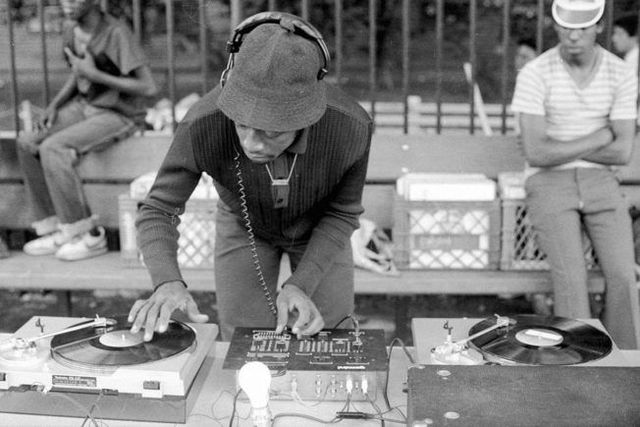Hip-Hop: From Kitchen Parties to Concert Halls
- October 12, 2025
- 0
This article traces the history of hip-hop from its origins in the Bronx during the 1970s to its rise as a cultural top genre
This article traces the history of hip-hop from its origins in the Bronx during the 1970s to its rise as a cultural top genre

There’s no one who hasn’t heard a hip-hop song at least once in their life. Today, we’ll talk about the origins of the most influential and popular trend in music.
Nowadays, hip-hop is more than just a musical genre. It’s a lifestyle, a symbol of modern youth culture with its own philosophy. It’s a commercially successful project that has impacted every sphere of society: from culture to politics.
Kanye West, Jay-Z, Lil Wayne, Nicki Minaj, Drake, Cardi B, Travis Scott… The list goes on and on. It’s hard to imagine that hip-hop wasn’t always a multi-billion dollar empire. But let’s rewind 50 years and recall a forgotten story.
We’re in the heart of the Bronx, where decay, unemployment, and crime reign. It was a boiling point that sparked something new. Amidst this chaos, hip-hop was born.
The man who hosted the first hip-hop party on Sedgwick Avenue (1520 Sedgwick Ave) on August 11, 1973, was DJ Kool Herc. It was a kitchen with two windows, where kids would party and enjoy music from nine at night until four in the morning. As contemporaries recall, the party was smoky, mesmerizing, and surreal.
Kool Herc became a true revolutionary in music. Behind the DJ booth, he played records of funk singer James Brown.
Herc would keep only certain parts of the track – drums and bass. He used two records and alternately spun them by hand, creating an endless beat. Thus, a new genre called breakbeat was born.
Besides, Kool had a friend with a microphone in hand – Coke La Rock. He acted as the event host, or MC, as they were called in hip-hop culture. Coke shouted short rhymes, energizing the crowd and keeping the mood.
“There’s not a disco that Kool Herc and Coke La Rock can’t rock.”
Herc forged the foundation for this musical genre, and the person who built hip-hop as a cultural movement was Afrika Bambaataa. He highlighted the five pillars of this culture: emceeing, DJing, graffiti, breaking, and a specific ideology. Bambaataa gathered a team with the aim of spreading hip-hop culture worldwide. He believed it could help pull teenagers out of the criminal world.
Gradually, the number of MCs and DJs in the Bronx increased, different groups emerged, and hip-hop evolved as a genre.
Grandmaster Flash played a significant role in this. In his childhood, he was obsessed with all kinds of electrical devices and things that spun. For example, a washing machine on spin cycle or bicycle wheels. As the DJ admits, he could watch for hours. Using Herc’s idea of two records, Flash demonstrated the great possibilities of mixing. He changed the structure of the track and created a new one to his liking.
But everything changed in 1979 when nearly bankrupt singer Sylvia Robinson assembled a group of three guys — The Sugarhill Gang. Inspired musicians literally wrote the song ‘Rapper’s Delight’ in one day, which blew the audience away. This track was played everywhere: on the radio, in cars, in every home. There wasn’t a person who didn’t know the song lyrics.
The genre of this song was then called new school funk, and now it’s known as old school rap. Thanks to this track, a wide audience learned about hip-hop. ‘Rapper’s Delight’ changed the rules of the game. Now many thought anyone could rap. But there was a plus: hip-hop spread beyond the Bronx. In one of the Manhattan clubs, Grandmaster Flash was introduced to the superstar of that time – Debbie Harry, the leader of the group Blondie, who performed a song about him.
Thus, among rappers, there was an interest in electronic music. Afrika Bambaataa was the first DJ who started playing such compositions for the public. He especially loved the German collective Kraftwerk. This combination of breakbeat, techno, and dub took hip-hop to a new level.
But things in the Bronx were still bad. Meanwhile, the group Grandmaster Flash and the Furious Five were offered to record a track. One of the group members later admitted that they didn’t plan to do anything like it and almost refused the song.
It was ‘The Message’ – a song with a sharp social message that resonated across the country. The track elevated hip-hop’s status from party music to a level of protest. It was a sort of window into America’s urban jungle: crime, prostitution, prison, early death. As always, many feared to speak the truth, but these guys expanded the horizons, creating a real anthem of the urban ghetto.
“Don’t push me ’cause I’m close to the edge. I’m trying not to lose my head.”
Even those who didn’t like such songs enjoyed ‘The Message’. This track proved that hip-hop could go beyond parties and become something bigger.
Thus began the golden era of hip-hop, which we will discuss next time.